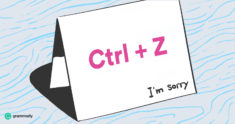
You screwed up. Now it’s time to own it. Knowing how to apologize is a crucial life and career skill. But when you write an apology letter, creating a permanent record of an event and your response to it, it’s all the more important that you get it right.
Why is writing an apology letter so hard?
Apologizing is an art form few of us seem to master. We don’t want to admit our mistakes because we think that making mistakes reflects badly on our character. But the truth is, not apologizing, or making a feeble non-apology, is often worse.
There are a few reasons you may struggle with apologies:
- You assume that making mistakes means you’re a bad person. When you feel ashamed, you have a hard time recognizing that one goof doesn’t reflect on your character as a whole.
- You get defensive. No one wants to feel ashamed. But a defense is not an apology.
- You worry that you’ll have to own all the responsibility, or that you’ll open the floodgate for more accusations. It could happen, sure. But not apologizing builds resentment over time, and that’s toxic to personal and workplace environments.
The good news is that when you put your apology in writing, you have the luxury of polishing and editing your thoughts so that they say precisely what you mean to convey.
The Elements of a Good Apology Letter
Sorry does seem to be the hardest word, but if you can master these steps in the apology process, you’re sure to make a good impression. These guidelines apply whether you’re apologizing for a personal error, or you’re writing an apology on behalf of a team or business.
- Say you’re sorry. Not, “I’m sorry, but . . .” Just plain ol’ “I’m sorry.”
- Own the mistake. It’s important to show the wronged person that you’re willing to take responsibility for your actions.
- Describe what happened. The wronged person needs to know that you understand what happened and why it was hurtful to them. Make sure you remain focused on your role rather than deflecting the blame.
- Have a plan. Let the wronged person know how you intend to fix the situation.
- Admit you were wrong. It takes a big person to own up to being wrong. But you’ve already reminded yourself that you’re a big person. You’ve got this.
- Ask for forgiveness. A little vulnerability goes a long way toward proving that you mean what you say.
—If You Want to Know How to Apologize, First Do This…
It’s as easy (and as hard) as that. No minimizing, no shifting blame, no defenses. Now, let’s take a look at some apology letter examples that follow this format.
Apology Letter Examples
Before you begin writing, there are a few pointers to keep in mind. First, keep your letter brief and to the point. Don’t ramble on about what happened—distill it to the essentials. Don’t exaggerate, either. There’s no need to fall on your sword. But do keep your language respectful, sincere, and professional.
The Third-Party Apology
If you supervise an employee who made a mistake and find yourself apologizing to a customer or client, it’s important that you take responsibility without dumping all the blame on the employee. After all, what your employees do reflects your leadership.
Dear Ms. Jones,
On behalf of ABC Office Equipment, I extend our sincerest apologies for the bad experience you had with our sales associate, James. I understand that James made unprofessional remarks when you visited our storefront to inquire about a new copier. You came to us in search of information, and instead were subjected to a pushy salesperson.
At ABC, it’s our goal to help you make an informed purchase decision without having to deal with aggressive sales tactics. James is a new employee that I’ve been training. I take full responsibility for his behavior. He has received a written reprimand and will be shadowing one of our senior sales associates until he has a better understanding of the ABC Office Equipment approach to customer service.
I’m grateful that you brought this issue to my attention and I ask your forgiveness. We’d love to earn your business. I’ve included a voucher for 20 percent off your next purchase in our store as a thank-you, should you decide to give us a second chance. We hope to see you again soon!
Kind regards,
Jennifer Smith
Equipment Sales Manager
The Personal Apology Letter
Sometimes, you have to own up to something you did that hurt or inconvenienced another person. We’ve all been there. Keep it simple. Don’t make excuses. Show that you’re trying to improve.
Dear Dylan,
I apologize for not arriving on time to pick you up from the airport yesterday afternoon. I have no excuse for keeping you waiting and wondering when your ride would show up.
It’s important to me not to let people down when they’re depending on me. Next time, I’ll make better use of calendar alerts so I’ll be sure to leave in plenty of time to arrive as scheduled, or even ahead of schedule.
I humbly ask your forgiveness. I hope my mistake won’t prevent you from seeking my help in the future. I’m always happy to be of service.
All the best,
Jillian
The Mass Apology
It’s horrifying to think about, but sometimes you end up upsetting a group of people rather than just one person. As with all apology letters, It’s important not to say, “I’m sorry if anyone felt offended.” (That’s like saying, “It’s too bad some of you don’t know how to handle my personality.”) Instead, say, “I’m sorry that I offended anyone.”
Hello Everyone,
I owe you all an apology. When I planned my costume for our annual company Halloween bash, I clearly wasn’t thinking. I now realize that what I wore was offensive to some of you, as well as to your families.
It was never my intention to cause anyone distress. Looking back, however, I can clearly see that I didn’t think things through before I decided on what to wear. Next time, I’ll be sure to weigh my warped sense of humor against my sense of propriety and choose something that isn’t controversial.
I hope you’ll forgive me for making you uncomfortable. Please accept the cupcakes in the breakroom as a sincere peace offering.
All the best,
Jamie
The post 3 Perfect Examples of How to Write an Apology Letter appeared first on Grammarly Blog.
